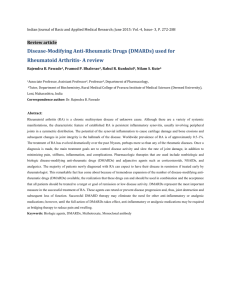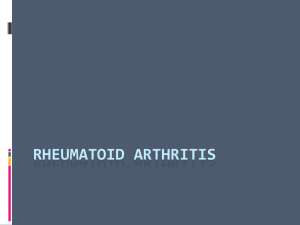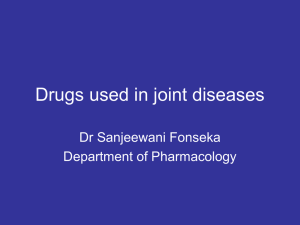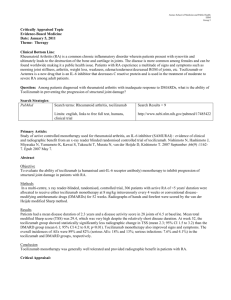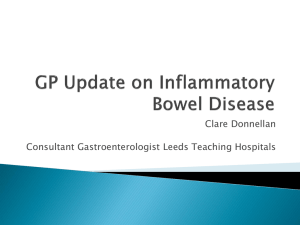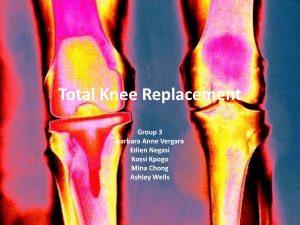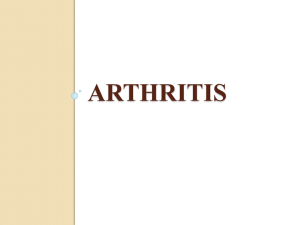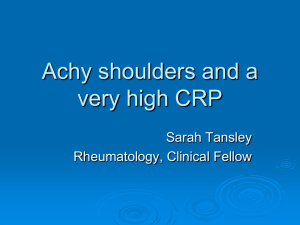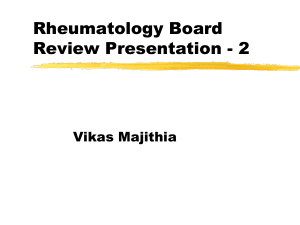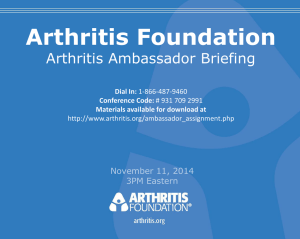Evidence Informed Best Practice RA OA
advertisement
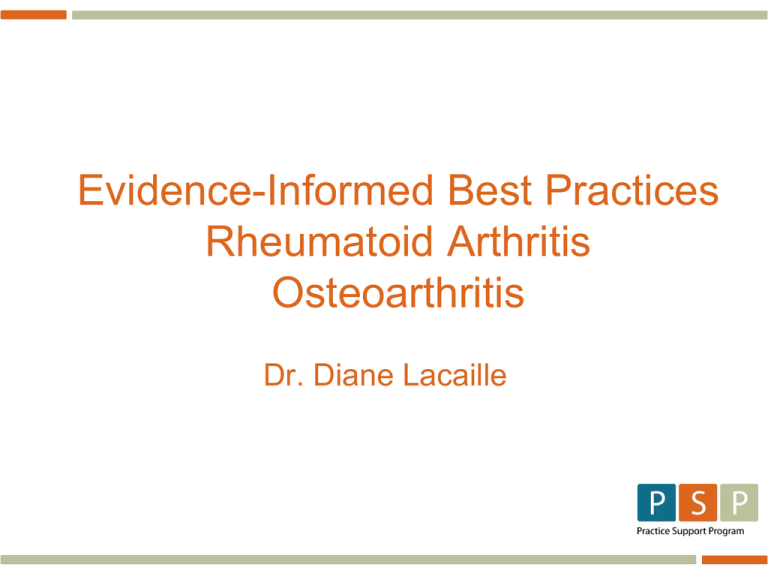
Evidence-Informed Best Practices Rheumatoid Arthritis Osteoarthritis Dr. Diane Lacaille Objective Describe the rationale for key recommendations for best practice care for Rheumatoid Arthritis and Osteoarthritis according to the BC Guidelines. www.bcguidelines.ca 2 Rationale for recommendations in guidelines Rheumatoid Arthritis Early diagnosis and early treatment with DMARDs Prevention of joint damage Management of co-morbidities Monitoring of disease activity Osteoarthritis Reduction of pain Improvement of function Optimization of conservative care Appropriate and timely referral for surgical intervention 3 4 EARLY Treatment of RA with DMARDs E EARLY DIAGNOSIS AND TREATMENT OF RA A AGGRESSIVE USE OF DMARDS ALTERS THE COURSE OF RA R REMISSION IS THE NEW TARGET OF RA TREATMENT L LONG TERM USE OF DMARDS Y YES, DMARDS ARE SAFE WHEN MONITORED REGULARLY This is the new standard of care. 5 RA is Not a Benign Disease If not controlled, RA inflammation leads to: joint damage and joint deformities progressive loss of physical function work disability (32-50% after 10 years of RA) premature mortality, mainly from cardiovascular disease (50% increase in risk of death from CVD) All these outcomes are preventable. 6 Persistent Joint Swelling Leads to Joint Damage & Deformities => 7 Early Diagnosis & Treatment of RA E A R L Y Early diagnosis Recognizing signs of inflammation – clues pointing to RA Early morning stiffness > 30 minutes Worse pain in the morning and post immobility Swelling of small joints Pain or tenderness on squeezing the MTPs, MCPs or wrists Symmetrical involvement Systemic symptoms, such as fatigue Ruling out other diagnosis Septic arthritis, especially if monoarthritis Crystal arthritis, such as gout or pseudogout Joint aspiration for acute monoarthritis to R/O infection or when crystal arthritis is suspected Transient inflammatory arthritis (viral) < 6 weeks Other inflammatory arthritis, also Rx with DMARDs 8 Early Diagnosis & Treatment of RA E A R L Y Early treatment of RA Capture the window of opportunity Early treatment with DMARDs alters the disease course. Joint damage occurs early (within months) and is irreversible. RA is more responsive to treatment early on. Early treatment increases the chances of remission. New onset RA requires urgent care DMARDs should be started within 2 months of symptoms. Referral to a rheumatologist for new onset RA should be seen within 4 weeks. State ‘new onset of RA’ on referral. Rheumatologists prefer early referrals. 9 Aggressive use of DMARDs Alters the course of RA E A R L Y What are DMARDs? Disease Modifying Anti-Rheumatic Drugs They improve symptoms and prevent joint damage. Methotrexate, Sulfasalazine, Hydroxychloroquine, Gold, Cyclosporine, Leflunomide and biologic agents. Think RA, think DMARDs All RA patients with active inflammation should be on a DMARD. NSAIDs and prednisone are not enough NSAIDs improve symptoms but fail to prevent joint damage. Prednisone should not be used alone because of long term toxicities 10 Role of steroids in RA Minimize steroids dose and duration, because of long term risks, esp. cardiovascular diseases Oral steroids do have a role: Small doses (< 10 mg daily), over short periods Bridging therapy, while waiting for DMARDs Early on at time of RA onset, but avoid prior to rheumatologist referral for diagnosis bcse masks signs. To control flare-ups Intramuscular (40 mg depomedrol) and intraarticular are good alternatives to oral. If steroids are needed to control disease, then DMARDs need to be adjusted 11 11 Aggressive Use of DMARDs Alters the Course of RA E A R L Y DMARDs alter the course of RA by: • Preventing joint damage and deformities • Reducing physical and work disability • Preventing premature mortality Aggressive use of DMARDs means: • Starting DMARDs early • Using DMARDs continuously, often in combination • Evaluating response every 1 to 3 months • Modifying DMARD therapy until the target is reached • Aiming to eradicate inflammation 12 Remission is the new target of RA treatment E A R L Y The goal of RA treatment is no longer to simply control symptoms, but to eradicate inflammation. The target of DMARD therapy is no signs of active inflammation i.e., • No swollen joints • Normal ESR or CRP • Little to no radiographic progression Although remission is the target, minimal disease activity may be an acceptable alternative, when remission is not possible, especially in established long-standing disease, or when co-morbidities or other patient factors limit DMARD options. 13 Long-term use of DMARDs E A R L Y DMARDs should be used continuously, throughout the disease. When sustained remission is achieved, DMARDs may be slowly decreased to find a lower dose that maintains remission. DMARD discontinuation is not recommended because of high risk of flare off DMARDs. All RA requires DMARD, the earlier the better, but even late RA requires DMARDs to reduce further damage. 14 Yes DMARDs are safe when monitored regularly E A R L Y Benefits Risks Benefits of early DMARDs outweigh their risks 15 16 EARLY is the new standard of care Family physicians play a critical role in early diagnosis and treatment of RA. DMARDs should be prescribed in all RA patients and should be started early. 17 Treatment of RA the standard of care has changed DMARDs NSAIDS 18 Management of Established RA Objective: Suppress inflammation, prevent joint damage Task Family Doctor Rheumatologist Monitor Q 2-6 months Q 6-12 months Assess disease activity (Joint Count + Blood Work) Review Meds, S/E Adherence/ Dosage Refer to PT/OT Review/adjust meds Rating of Disease Activity for decisionmaking Assess Joint Damage Pain Relief same Refer PT/OT, surgery Review for Comorbidities Screen and Treat Screen and Treat 19 Consider chronic disease implications Comorbidities Dealing with Chronic Pain Psychosocial Issues Increased infection risk Immunizations Osteoporosis Cardiovascular Disease Smoking Cessation Weight Management 20 Osteoarthritis Osteoarthritis (OA) Features suggestive of OA: Absence of inflammatory features: morning stiffness < 30 min; gelling < 5 min; minimal swelling & heat; no redness. Pain worse with activity, better with rest Advanced OA => constant pain including at rest Absence of systemic symptoms Gradual onset History of prior injury (e.g. knee), prior deformity / malalignement Joint distribution: hips, knees, C & L spine, hands: DIP, PIP, 1st CMC, 1st MTP. Bony enlargement, crepitus, malalignement If joint swelling, synovial fluid non-inflammatory, no crystals. 22 Joint Distribution Black= joints most commonly affected Grey= joints often affected White= joints usually not affected 23 Other Diagnoses to Exclude Septic arthritis (acute monoarthritis requires joint aspiration) Crystal arthritis: gout, pseudogout (CPPD) (joint aspiration) Inflammatory arthritis: esp. psoriatic arthritis Non-articular : e.g. bursitis (trochanteric, pes anserine), tendonitis (shoulder, elbow) Bone pain (multiple myeloma, metastasis) Soft tissue pain syndromes Referred pain 24 Investigations X Rays › Provide clinical information › Can be normal in early OA › Often don’t correlate with degree of pain › Knee Xrays must be ordered weight bearing (PA, lat, skyline) › Hip (OA hip series: incl. lateral view and upper 1/3 femur) Absence of inflammatory markers (CBC, CRP normal) Labs can be useful to rule out other conditions (e.g. thyroid disease) or to assess for comorbidities prior to Rx (e.g. Cr, LFT) 25 Management - Considerations Severity of pain (with activity, at rest, interferes with sleep) Impact on function (ADLs, IADLs) Impact on participation (work, family obligations, social activities, leisure) Impact on independence Psychosocial issues (pain amplification, coping strategies, depression, adherence to treatment, social support) 26 Patient Education (OA and RA) Guidelines Patient Support Family Support Community Support Patient Self Management (coping with pain and other arthritis symptoms, stress, lifestyle changes e.g. exercise). Arthritis Self Management Program (ASMP) and CDSMP. 27 Management – Non pharmacological Patient education Self-management Weight management – support, dietician Exercise (ROM, strengthening, aerobic) Physiotherapy: prescribe specific therapeutic exercise program Walking aids Occupational therapy: Orthotics, footwear, braces, splints, ADL aids, ergonomic modifications at work 28 Management - Pharmacological Acetaminophen: › regular schedule vs. prn › up to 4 gm/day, less if liver disease NSAIDs: › Gastroprotection if high GI risk › Consider cardiovascular risk factors › Topical NSAIDs Glucosamine and chondroitin sulfate: › Not recommended, insufficient evidence of efficacy Intra-articular steroids Hyaluronic acid – limited benefit, can cause inflammatory reaction 29 30 Summary Differentiating inflammatory from non-inflammatory arthritis Importance of early diagnosis and DMARD treatment in RA Monitoring of disease activity to achieve treatment target Goal of preventing joint damage, consequences of inflammation Management of pain, improvement of function in OA Weight management, exercise and rehab in OA Multidisciplinary care of arthritis Appropriate and timely referral for surgery Management of co-morbidities, esp. cardiovascular diseases Need for shared approach to care Importance of patient education and self-management 31
